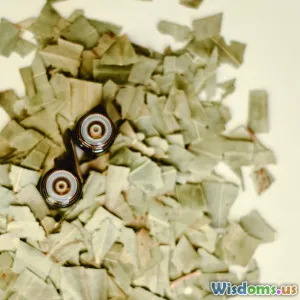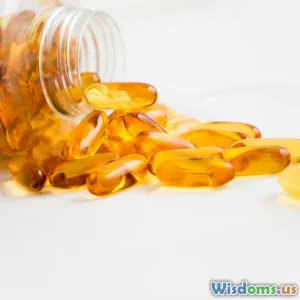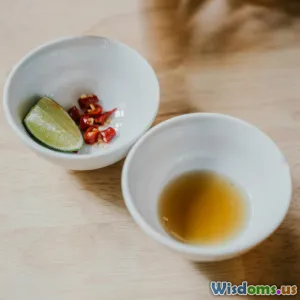
Sustainable Beauty: Eco Friendly Products to Try
9 min read Explore sustainable beauty with eco-friendly products that transform your routine while protecting the planet. (0 Reviews)
Sustainable Beauty: Eco-Friendly Products to Try
Introduction
The beauty industry has long been celebrated for its creativity and innovation, but it’s no secret that its environmental footprint can be substantial. From excessive packaging waste to harmful chemical ingredients, many traditional beauty products contribute to pollution, resource depletion, and harm to ecosystems. However, a growing movement within the fashion and beauty world is transforming how we think about self-care: sustainable beauty.
Sustainable beauty focuses on products and practices that minimize environmental impact while enhancing personal health. This means embracing eco-friendly products that offer effectiveness, transparency, and ethical responsibility. Whether you're a seasoned eco-conscious consumer or just beginning your green journey, this comprehensive article will guide you through the compelling reasons behind sustainable beauty and showcase eco-friendly products worth trying now.
Why Sustainable Beauty Matters
The Environmental Impact of Conventional Beauty Products
The global beauty industry generates an estimated 120 billion units of packaging waste annually, with much of this ending up in landfills and oceans. According to the Ellen MacArthur Foundation, plastic packaging from beauty products is one of the fastest-growing sources of plastic pollution.
Furthermore, many conventional products include synthetic chemicals such as parabens, sulfates, and phthalates that can persist in the environment, disrupting aquatic life and harming biodiversity. The production of ingredients like palm oil has also been linked to deforestation, threatening wildlife habitats.
Consumer Demand Driving Change
According to a 2023 Nielsen report, 73% of global consumers are willing to change their consumption habits to reduce environmental impact. This shift is driving brands to reformulate products with natural, biodegradable ingredients and adopt zero waste packaging.
Health Benefits of Sustainable Ingredients
Sustainable beauty products commonly use organic and plant-based ingredients free from harmful chemicals. Switching to such products reduces exposure to toxins potentially linked to allergies, hormonal disruption, or skin irritations. Rosemary Lancaster, a holistic dermatology expert, highlights that "clean beauty isn’t just good for the planet; it’s also better for your skin’s long-term health."
Key Elements of Eco-Friendly Beauty Products
Natural and Organic Ingredients
Eco-friendly beauty prioritizes ingredients sourced from sustainable farming practices, often certified organic. Examples include aloe vera, jojoba oil, chamomile, and green tea extracts, all known for their skin benefits and renewability.
Biodegradable and Recyclable Packaging
Packaging is a major factor in sustainability. Brands now experiment with refillable containers, compostable paper-based packaging, or post-consumer recycled plastics. Giants like L’Oréal and smaller indie brands alike have pledged to use 100% recyclable or compostable packaging by 2030.
Cruelty-Free and Ethical Sourcing
Ethically sourced ingredients ensure fair wages and safe conditions for farmers, often supporting fair trade initiatives. Moreover, cruelty-free certification means products are not tested on animals, reinforcing compassionate beauty.
Minimal Carbon Footprint
Some brands measure and offset their carbon emissions or prioritize local sourcing to reduce transportation impact. For instance, Dr. Hauschka sources many ingredients from regional biodynamic farms, minimizing emissions.
Eco-Friendly Beauty Products to Try Today
1. Dr. Bronner’s Pure-Castile Liquid Soap
This multipurpose liquid soap boasts USDA-certified organic and fair trade ingredients. Its biodegradable formula is gentle on skin and safe for use as a body wash, shampoo, or household cleaner, reducing the need for multiple products.
2. Ethique Solid Shampoo Bars
Ethique offers shampoo, conditioner, and body bars that are plastic-free, vegan, and biodegradable. Solid bars have minimal packaging, last longer, and eliminate plastic bottle waste. Their bars, like "Hero" for moisturizing hair, consistently receive excellent reviews.
3. Tata Harper Regenerating Cleanser
Made on a Vermont farm, Tata Harper’s products exemplify luxury and sustainability combined. The Regenerating Cleanser features non-toxic botanicals and is packaged in recyclable glass with compostable labeling.
4. RMS Beauty “Un” Cover-Up Foundation
RMS Beauty uses ingredients like organic coconut oil and cocoa seed butter. Their foundation offers natural coverage and is housed in recyclable aluminum packaging. The brand advocates for freshness, avoiding synthetic preservatives.
5. Lush Galaxy Solid Perfume
Lush’s solid perfumes are packaged in recyclable or compostable materials, eliminating liquid packaging waste. Their fragrances often use natural essential oils sustainably sourced from around the world.
6. Elate Cosmetics Bamboo Makeup Brushes
Sustainably harvested bamboo handles and synthetic, cruelty-free bristles make these brushes eco-friendly alternatives to conventional makeup tools crafted chiefly from plastic.
How to Incorporate Sustainable Beauty into Your Routine
Conduct an Ingredient Audit
Read product labels carefully. Avoid ingredients associated with environmental damage such as microplastics and synthetic fragrances.
Choose Multi-Use Products
Seek products like solid soaps or tinted moisturizers that serve multiple purposes. This simplifies your routine and reduces overall consumption.
Prioritize Minimal and Recyclable Packaging
Look for brands committed to zero waste goals and take advantage of refill schemes whenever possible.
Support Transparent Brands
Follow brands that openly share sourcing practices, environmental impact reports, and certifications like USDA Organic, Fair Trade, or Leaping Bunny for cruelty-free.
DIY Sustainable Beauty
Consider making simple facial masks, scrubs, or hair rinses at home using natural ingredients like honey, oats, or green tea. This reduces packaging waste and guarantees ingredient quality.
The Bigger Picture: Impact and Future Trends
As awareness continues to rise, the beauty industry is anticipated to shift further towards greener principles. Industry forecasts from Allied Market Research predict the global green beauty market will reach $21 billion by 2027, growing at a CAGR of 8.4%. This economic incentive encourages innovation not just in products but in sustainable sourcing, ethical labor, and waste reduction.
Consumer advocacy groups emphasize the importance of policy changes combining corporate accountability with consumer education. The EU’s recent restrictions on single-use plastics and chemical safety mark significant legislative steps supporting sustainable beauty.
Conclusion
Sustainable beauty is more than just a trend; it’s a necessary transformation fostering harmony between self-care and stewardship of our planet. By choosing eco-friendly products, consumers wield incredible power to promote ethical business practices, reduce pollution, and safeguard biodiversity.
As demonstrated, high-performing sustainable beauty products are abundant and accessible—whether in the form of solid shampoo bars, organic skincare, or responsibly packaged makeup. Transitioning to these alternatives benefits not only your health but also the health of the Earth.
The next time you shop for beauty essentials, remember that each purchase tells a story. Choosing sustainable beauty is a choice to support innovation, community, and environmental resilience. Unlock a greener, cleaner, and kinder beauty experience—your skin and the planet will thank you.
References
- Ellen MacArthur Foundation, "The new plastics economy: Rethinking the future of plastics" (2016).
- Nielsen Global Survey on Sustainability, 2023.
- Tata Harper Skincare, official sustainability reports.
- Allied Market Research, Global Green Beauty Market Forecast (2021–2027).
- EU Directive on Single-Use Plastics (2019).
- Interview with Rosemary Lancaster, Holistic Dermatologist, 2023.
Rate the Post
User Reviews
Popular Posts





















